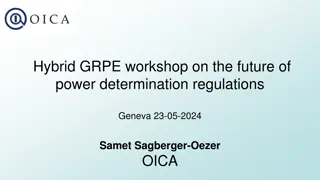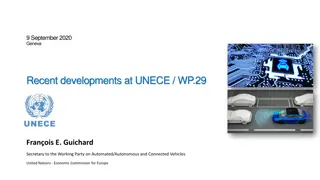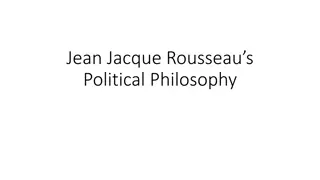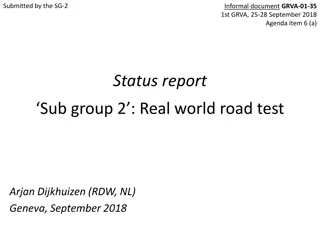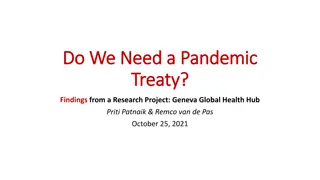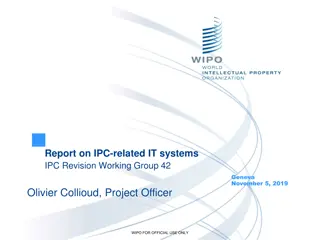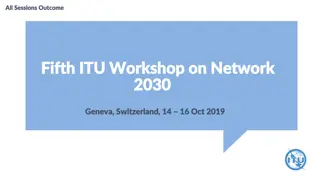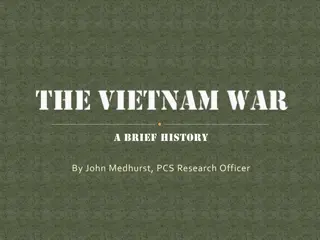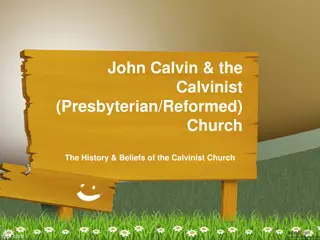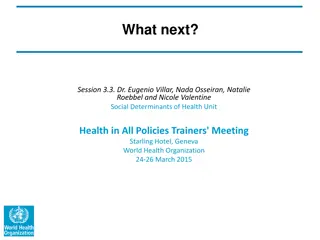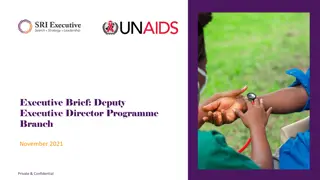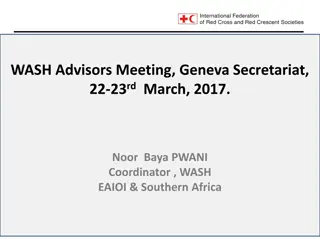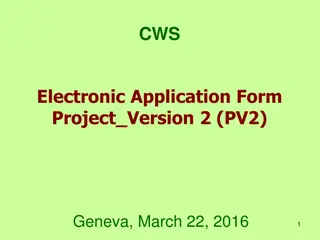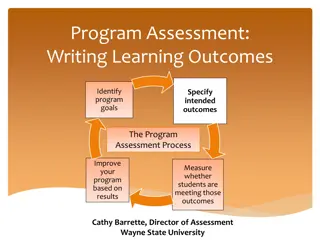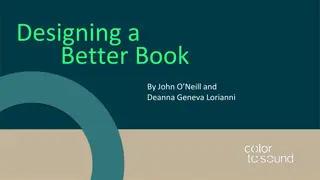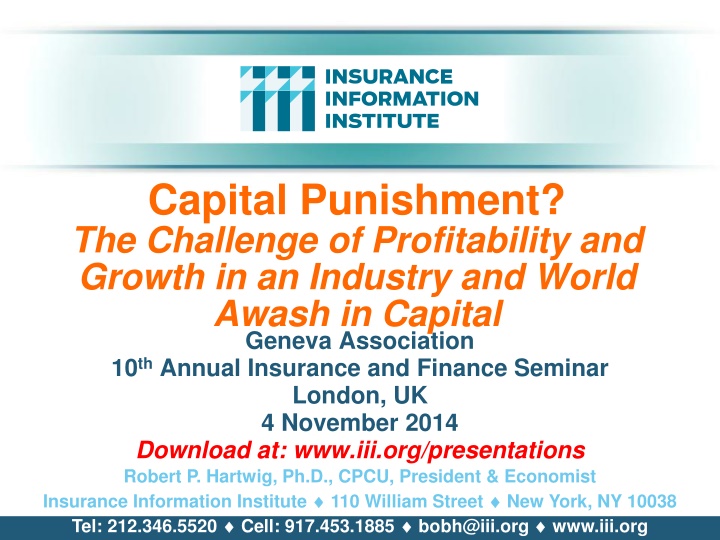
Challenges and Opportunities in the Global Financial Landscape
Explore the complexities of capital punishment and the financial industry's quest for profitability and growth in a world abundant with capital. From insurance to pension funds, discover the implications of excessive capital and the evolving investment landscape. Stay informed with insights from industry experts shared at the Geneva Association 10th Annual Insurance and Finance Seminar.
Download Presentation

Please find below an Image/Link to download the presentation.
The content on the website is provided AS IS for your information and personal use only. It may not be sold, licensed, or shared on other websites without obtaining consent from the author. If you encounter any issues during the download, it is possible that the publisher has removed the file from their server.
You are allowed to download the files provided on this website for personal or commercial use, subject to the condition that they are used lawfully. All files are the property of their respective owners.
The content on the website is provided AS IS for your information and personal use only. It may not be sold, licensed, or shared on other websites without obtaining consent from the author.
E N D
Presentation Transcript
Capital Punishment? The Challenge of Profitability and Growth in an Industry and World Awash in Capital Geneva Association 10thAnnual Insurance and Finance Seminar London, UK 4 November 2014 Download at: www.iii.org/presentations Robert P. Hartwig, Ph.D., CPCU, President & Economist Insurance Information Institute 110 William Street New York, NY 10038 Tel: 212.346.5520 Cell: 917.453.1885 bobh@iii.org www.iii.org
A World Awash in Capital Too Much of a Good Thing? The Global Glut of Capital is Not Unique to (Re)Insurance 2 2
S&P 500 (Excl. Financials): Cash & Short-Term Investments Cash and ST investments holdings have nearly doubled since 2007 Holdings of Cash and Liquid Asset Holdings Have Soared Across Virtually All Industries Since the Financial Crisis Source: Fact Set Fundamentals. 3
Hedge Fund Industry: Assets Under Management: 1997 2014:Q21 ($ Billions) $3,000 $2,352.6 $2,156.7 $2,136.8 $2,500 $1,798.7 $1,713.1 $1,710.0 $1,693.9 $1,554.1 $1,457.9 $2,000 $1,360.7 $1,229.0 $1,500 $825.6 $1,000 Assets managed by hedge funds are up 63% or $894.7 billion since 2008 to $2.35 trillion $505.5 $321.9 $236.6 $188.9 $143.1 $118.2 $500 $0 97 98 99 00 01 02 03 04 05 06 07 08 09 10 11 12 13 14:Q2 Yield Hungry Pension Funds Have Grown Rapidly Since the Financial Crisis, Deploying Oceans of Capital in Industries Across the Globe Including the Global Reinsurance Industry 1 Figures for 2011-2013 are as of Q4 for each year. Sources: BarclayHedge: http://www.barclayhedge.com/research/indices/ghs/mum/Hedge_Fund.html; Insurance Information Institute.
Global Pension Assets Growth, 2008 2013* Global pension assets for the top 13 pension markets reached $31.98 trillion in 2013 (+9.5% from 2012), an amount equal to 83.4% of these economies Compound Annual Growth Rate (%) CAGR of pension fund assets in most major pension markets has been quite strong since the financial crisis 16% 14.9% 13.3% 14% 11.4% 10.6% 12% 10.1% 9.9% 8.6% 8.4% 10% 8.0% 8% 6.4% 5.5% 6% 4.4% 4% 2.3% 2% 0% US UK South Africa Japan Germany Ireland Brazil Canada Australia Switzerland France Hong Kong Netherlands *As of year-end. Source: Towers Watson Global Pensions Asset Study 2014 at: http://www.towerswatson.com/en-US/Insights/IC-Types/Survey- Research-Results/2014/02/Global-Pensions-Asset-Study-2014 5 5
Pension Asset Allocation (World s 7 Largest Pension Markets) Alternative investment s share of assets is up +15 points since 2001 from 5% to 18% Holdings of Cash and Liquid Asset Holdings Have Soared Across Virtually All Industries Since the Financial Crisis *Australia, Canada, Japan, Netherlands, Switzerland, UK, US. Source: Towers Watson Global Pensions Asset Study 2014 at: http://www.towerswatson.com/en-US/Insights/IC-Types/Survey- Research-Results/2014/02/Global-Pensions-Asset-Study-2014 6
U.S. Policyholder Surplus: 1975 2014* ($ Billions) $750 Surplus as of 6/30/14 was a record $671.6, up 2.8% from $653.3 of 12/31/13, and up 53.6% ($234.5B) from the crisis trough of $437.1B at 3/31/09 $700 $650 $600 $550 $500 $450 $400 $350 $300 $250 $200 Surplus is a measure of underwriting capacity. It is analogous to Owners Equity or Net Worth in non-insurance organizations $150 $100 $50 $0 75 77 79 81 83 85 87 89 91 93 95 97 99 01 03 05 07 09 11 13 The Premium-to-Surplus Ratio Stood at $0.73:$1 as of 6/30/14, a Near Record Low (at Least in Recent History) * As of 6/30/14. Source: A.M. Best, ISO, Insurance Information Institute.
Premium-to-Surplus Ratio: 1985 2014* The larger surplus is in relation to premiums the lower the P:S ratio and the great the industry s capacity to handle the risk it has accepted (Ratio of NWP to PHS) $2.00 Surplus as of 6/30/14 was $0.73:$1, a record low (at least in modern history) $1.90 $1.80 Financial crisis had virtually no effect on the capital adequacy of the US nonlife insurance sector $1.70 $1.60 $1.50 $1.40 $1.30 $1.20 $1.10 $1.00 $0.90 $0.80 9/11, Recession & Hard Market $0.70 $0.60 $0.50 85 86 87 88 89 90 91 92 93 94 95 96 97 98 99 00 01 02 03 04 05 06 07 08 09 10 11 12 13 14* The Premium-to-Surplus Ratio Stood at $0.73:$1 as of 6/30/14, a Record Low (at Least in Recent History) * As of 6/30/14. Source: A.M. Best, ISO, Insurance Information Institute.
A World of Low Yields Capital Will Seek Its Highest (Risk-Adjusted) Return 10 10
U.S. Treasury Security Yields: A Long Downward Trend, 1990 2014* 9% Yields on 10-Year U.S. Treasury Notes have been essentially below 5% for a full decade. U.S. Treasury yields plunged to historic lows in 2013. Longer- term yields have rebounded a bit. 8% 7% 6% 5% 4% 3% 2% Recession 2-Yr Yield 10-Yr Yield 1% 0% '90 '91 '92 '93 '94 '95 '96 '97 '98 '99 '00 '01 '02 '03 '04 '05 '06 '07 '08 '09 '10 '11 '12 '13 '14 Since roughly 80% of P/C bond/cash investments are in 10-year or shorter durations, most P/C insurer portfolios will have low-yielding bonds for years to come. *Monthly, constant maturity, nominal rates, through September 2014. Sources: Federal Reserve Bank at http://www.federalreserve.gov/releases/h15/data.htm. National Bureau of Economic Research (recession dates); Insurance Information Institute. 11 11
Key European Central Bank Interest Rates, 2000 - 2014 ECB s cut its key rate to 0.05% on 4 Sept. 2014 Interest Rates Have Been Slashed by Most Major Central Banks, Igniting a Global Quest for Yield. Reinsurance Is Just One of Many New Areas Discovered by Large Institutional Investors Source: European Central Bank from www.cbrates.com; Insurance Information Institute. 12
Alternative Capital in Global Reinsurance Markets The Global Hunt for Yield Pushed Institutional Investors Into Countless New Areas (Re)Insurance Being One of Them 13 13
Mentions of the Term Alternative Capital with Insurance or Reinsurance 800 712 700 600 500 409 400 300 200 116 83 79 100 59 55 52 43 35 29 20 21 11 9 0 00 01 02 03 04 05 06 07 08 09 10 11 12 13 14* Should the Increased Use of Terms Such as Alternative Capital, Hedge Fund and Pension Fund in Conjunction with a (Re)Insurance Be a Concern * Estimate is annualized figure based on actual data through September 30, 2014. Source: Insurance Information Institute search of Factiva database. 14
Global Reinsurance Capital (Traditional and Alternative), 2006 - 2014 Total reinsurance capital reached a record $570B in 2013, up 68% from 2008. (Billions of USD) 570 $600 540 505 470 $500 455 410 400 385 $400 340 511 $300 490 466 447 428 388 378 368 $200 321 $100 17 22 19 22 24 28 39 50 59 $0 2006 2007 2008 2009 2010 Traditional Capital 2011 2012 Total 2013 2014 Alternative Capital But alternative capacity has grown 210% since 2008, to $50B. It has more than doubled in the past three years. 2014 data is as of June 30, 2014. Source: Aon Benfield Analytics; Insurance Information Institute.
Global Reinsurance Capital Share (Traditional and Alternative), 2006 - 2014 11.5% 12% 10.2% 10% 8.4% 8% 6.5% 5.9% 5.8% 5.7% 5.4% 6% 4.6% 4% 2% 0% 2006 2007 2008 2009 2010 2011 2012 2013 2014 Alternative Capital s Share of Global Reinsurance Capital Has More Than Doubled Since 2010. 2014 data is as of June 30, 2014. Source: Aon Benfield Analytics; Insurance Information Institute.
Growth in Traditional and Alternative Capital, 2007-2014 Post 2011, alternative capital is growing four and five times faster than traditional capital. 2009-10: Low cat losses, recovering markets fueled traditional capital growth. (Change from Previous Year) 39% 40% Economic meltdown depleted all forms of capital. 29% 28% 30% 18% 18% 18% 17% 20% 16% 9% 9% 10% 5% 5% 4% 0% Japan, NZ quakes, US tornadoes drove traditional capital slightly lower. -4% -10% -14% -20% -17% 2008 2007 2009 2010 2011 2012 2013 2014 Alternative Capital Traditional Capital Alternative capital has grown 247% since 2006, vs. 39% growth in traditional capital. 2014 reflects growth through June 30 from prior year end. Source: Aon Benfield Analytics; Insurance Information Institute.
Growth of Alternative Capital Structures, 2002 - 2014 (Billions of USD) Collateralize Re s Growth Has Accelerated in the Past Three Years. $30 $25 $20 $15 $10 $5 $0 2002 2003 2004 Cat Bonds 2005 2006 Sidecars 2007 2008 ILWs 2009 2010 Collateralized Re 2011 2012 2013 2014 Collateralized Reinsurance and Catastrophe Bonds Currently Dominate the Alternative Capital Market. 2014 data is as of June 30, 2014. Source: Aon Benfield Analytics; Insurance Information Institute.
ILS: Issuance and Outstanding, 1997- 2014:Q2 Risk Capital Amount ($ Millions) $24,000 Risk Capital Outstanding Is at a Record 20,532.4 17,042.9 16,479.2 15,676.8 22,920.6 $20,000 14,865.5 14,043.6 13,691.1 $16,000 10,114.5 $12,000 8,241.6 Financial Crisis Depressed Issuance 7,641.7 6,441.5 6,632.7 6,279.2 1,884.1 2,378.9 5,695.7 1,004.8 4,644.5 4,594.5 5,024.8 2,801.4 4,580.3 $8,000 895.6 3,479.8 2,979.9 1,125.0 $4,000 2,500.0 966.9 824.8 742.2 714.0 2,388.2 989.5 1,142.8 $0 97 98 99 00 01 02 03 04 05 06 07 08 09 10 11 12 13 14:Q2 Risk Capital Issued Risk Capital Outstandng at Year End Model Uncertainty, Concerns on Economy Pushed Issuance Lower. 2014 Has Seen the Largest Cat Bond Ever - $1.5 Billion (Florida Citizens). Bond Issuance Will Set a Record. Sources: Artemis.bm, Insurance Information Institute.
Cat Bond: Investor by Category Reinsurer 6% Hedge Fund 5% 2014 Reinsurer 5% 2012 Hedge Fund 5% Mutual Fund 5% Mutual Fund 11% Institutional 32% Institutional 34% Catastrophe Fund 46% Catastrophe Fund 51% Mutual Funds Share of Cat Bond Purchases is Growing; Most Hedge Funds Participate Via Collateralized Reinsurance. Years ended June 30. Source: Aon Benfield Securities; Insurance Information Institute.
Catastrophe Bonds Outstanding, Q2 2014 U.S. Wind and Quake 35% Catastrophe Bonds Are Heavily Concentrated in U.S. Hurricane Exposures. More Than 70 Percent of Catastrophe Risks Outstanding Cover U.S. Wind Risks. Japanese Perils 4% Other (ex. U.S. Wind) 8% U.S. Wind 26% U.S. Quake 7% Euro Wind 9% Other (incl. U.S. Wind) 11% Source: Willis Capital Markets, Insurance Information Institute. 21
Alternative Capital Is Impacting the Reinsurance Pricing Environment Traditional and Alternative Returns Are Under Pressure 22 22
U.S. Wind-Exposed Risk Premium* 2010:Q1 to 2014: Q1 Risk spreads rose in 2011- 2012 from cat activity and changes to catastrophe models. 13.0% Risk spreads dropped equivalent to lower rates low cat losses, capital entering market. Risk Spread (coupon risk-free rate) 12.0% 12.0% 11.6% 11.0% 12.0% 11.0% 10.9% 10.9% 10.0% 10.1% 9.0% 7.6% 8.0% 8.2% 8.2%8.0% 7.9% 8.2% 7.0% 8.0% 7.4% 7.2% 6.4% 6.0% 6.2% 5.0% * Trailing 12-month average SOURCE: Willis Capital Markets, Insurance Information Institute. 23
Non-U.S. Wind-Exposed Risk Premium* 2010:Q1-2014: Q1 Spreads are also falling in non-U.S. wind exposures, but less sharply and in line with expected losses 10.0% Risk Spread (coupon risk-free rate) 9.0% 8.5% 8.0% 7.2% 6.9% 7.0% 6.0% 5.6% 4.2% 5.4% 4.9% 4.8% 5.7% 5.0% 5.7%5.7% 4.2% 4.5% 4.0% 3.6% 4.2% 2.7%2.6% 3.0% Wtd. Avg. Risk Spread 2.0% * Trailing 12-month average. SOURCE: Willis Capital Markets, Insurance Information Institute. 24
Reinsurance Pricing: Change in Rate on Line for U.S. CAT Business Alternative Capital, Low Levels of Catastrophe Drive Rates Down. 76% 2006: Higher Rates After Record Hurricanes. (Change from Previous Year) 40% 2001-02: WTC Losses, Falling Stock, Bond Prices Dry Up Capital. Japan, NZ Quakes, US Tornadoes. 30% 20% 14% 14% 10% 7% 10% 0% -3% -6% -10% -7% -9% -11% -12% -16% 2008 -20% -17% 2014 2002 2003 2004 2005 2006 2007 2009 2010 2011 2012 2013 Some Observers Predict Catastrophe Prices Will Fall Another 10 Percent in 2015, Driven by Emergence of New Capital. 2014 reflects growth through June 30 from prior year end. Source: Guy Carpenter; Insurance Information Institute.
What Is Happening to Insurer Profitability? Has Capital Accumulation Impacted Profitability? D j Vu: Does History Suggest Cycles or Super-Cycles in Insurance? 27 27
Profitability Peaks & Troughs in the P/C Insurance Industry, 1975 2014:H1* ROE History suggests next ROE peak will be in 2015-2016 1977:19.0% 1987:17.3% 25% 20% 2006:12.7% 1997:11.6% 2013 10.4% 15% 9 Years 10% 5% 2014:H1 7.7% 0% 2001: -1.2% 1975: 2.4% 1984: 1.8% 1992: 4.5% -5% 75 76 77 78 79 80 81 82 83 84 85 86 87 88 89 90 91 92 93 94 95 96 97 98 99 00 01 02 03 04 05 06 07 08 09 10 11 12 13 14 *Profitability = P/C insurer ROEs. 2011-14 figures are estimates based on ROAS data. Note: Data for 2008-2014 exclude mortgage and financial guaranty insurers. Source: Insurance Information Institute; NAIC, ISO, A.M. Best.
P/C Insurance ROE as 5-Year Moving Average After smoothing, there is a more evident trend over the past 40 years toward lower peak profitability The Tradeoff: Impairment rates have plunged Source: Jessica Weinkle, Insurance Journal, An Average Perspective Based Insurance Profitability Cycles, October 6, 2014, based om I.I.I. data, http://www.insurancejournal.com/magazines/closingquote/2014/10/06/342096.htm. 30
P/C Insurance ROE Index (1974-2014:Q1 = 100) Lower peak profitability seems to be the norm after 1994. Is RBC a cause? Greater use of modeling? Lower interest rates? The Tradeoff: Industry impairment rates have plunged Source: Jessica Weinkle, Insurance Journal, An Average Perspective Based Insurance Profitability Cycles, October 6, 2014, based om I.I.I. data, http://www.insurancejournal.com/magazines/closingquote/2014/10/06/342096.htm. 31
Back to the Future: Profitability Peaks & Troughs in the P/C Insurance Industry, 1950 2014* 1970-90: Peak ROEs were much higher in this period while troughs were comparable. High interest rates, rapid inflation, economic volatility all played roles ROE 1990-2010s: D j vu. Excluding mega- CATs, this period is very similar to the 1950-1970 period 1950-70: ROEs were lower in this period. Low interest rates, low inflation, Bureau rate regulation all played a role 25% 1977:19.0% 20% 1987:17.3% 2006:12.7% 1972:13.7% 1997:11.6% 15% 2013 10.4% 1950:8.0% 1966-67: 5.5% 10% 1959:6.8% 5% 2014:H1 7.7% 1969: 3.9% 0% 1992: 4.5% 1984: 1.8% 1975: 2.4% 1965: 2.2% 1957: 1.8% 2001: -1.2% -5% 50 52 54 56 58 60 62 64 66 68 70 72 74 76 78 80 82 84 86 88 90 92 94 96 98 00 02 04 06 08 10 12 14:H1 *Profitability = P/C insurer ROEs. 2011-14 figures are estimates based on ROAS data. Note: Data for 2008-2014 exclude mortgage and financial guaranty insurers. 2014 figure is through Q2. Source: Insurance Information Institute; NAIC, ISO, A.M. Best.
Average ROE for the P/C Insurance Industry by Decade, 1950s 2010s Profitability peaked in the 1970s and 1980s but has tapered off since then Average Annual Percent Change (%) P/C profitability was much lower in the 1960s and 1970s 14% 11.5% 11.2% 12% 10% 8.4% 7.3% 7.0% 8% 5.7% 6% 4.2% 4% 2% 0% 1950-59 1960-69 1970-79 1980-89 1990-99 2000-09 2010-14* Profitability in the current low yield, low Inflation environment has declined since the highs of the 1970s and 1980s, but is above that of the 1950s and 1960s and the industry s impairment rates have dropped since the 1980s Sources: Insurance Information Institute research. 33 33
BANK LESSON: Profitability, Capital and Systemically Important Banks Global Systemically Important bank Tier-1 capital ratios are up since the global financial crisis, but ROEs are lower The Message from Bank Regulators: Get used to it! Source: The Economist, No Respite, September 27, 2014. 35
P/C Insurer Impairments, 19692013 Impairments among P/C insurers remain infrequent 70 60 58 60 55 50 50 49 49 48 47 50 41 40 36 35 34 34 34 31 31 29 30 25 21 19 19 19 18 18 20 16 16 16 15 15 14 14 14 13 13 12 12 12 11 9 9 9 10 7 5 0 92 09 70 71 72 73 74 75 76 77 78 79 80 81 82 83 84 85 86 87 88 89 90 91 93 94 95 96 97 98 99 00 01 02 03 04 05 06 07 08 10 11 12 13 The Number of Impairments Varies Significantly Over the P/C Insurance Cycle, With Peaks Occurring Well into Hard Markets Source: A.M. Best Special Report U.S. P/C Impairments Down Sharply in 2013; Alternative Risk Players Faltered, June 23, 2014; Insurance Information Institute. 36
P/C Insurer Impairment Frequency vs. Combined Ratio, 1969-2013 120 2.0 Combined Ratio after Div P/C Impairment Frequency 1.8 115 1.6 1.4 110 Impairment Rate Combined Ratio 1.2 105 1.0 0.8 100 0.6 0.4 95 0.2 2013 impairment rate was 0.43%, down from 0.76% in 2012; the rate is lower than the 0.81% average since 1969 90 0.0 69 70 71 72 73 74 75 76 77 78 79 80 81 82 83 84 85 86 87 88 89 90 91 92 93 94 95 96 97 98 99 00 01 02 03 04 05 06 07 08 09 10 11 12 13 Impairment Rates Are Highly Correlated With Underwriting Performance and Reached Record Lows in 2007; Recent Increase Was Associated Primarily With Mortgage and Financial Guaranty Insurers and Not Representative of the Industry Overall Source: A.M. Best; Insurance Information Institute 37
Summary Capital Accumulation is Not Unique to (Re)Insurance Large corporations, institutional investors (e.g., pension funds), hedge funds, sovereign wealth funds have experienced rapid cash (or equivalent) accumulation All Are Chasing Yield Globally Capital Has Generally Been Accumulating on the Balance Sheets of Nonlife (Re)Insurers for Years Era of rapid accumulation pre-dates financial crisis Pace has accelerated post-financial crisis Profits, capital gains and alternative capital all contribute 39
Summary (Continued) Nonlife ROEs Have Trended Downward Downward trend pre-dates financial crisis Capital accumulation, RBC requirements are factors; Low yields Tradeoff: Impairment rates have trended downward Quantum Shift or Evidence of a Super-Cycle? Profitability patterns today are more reminiscent of the pre-1970 era (and in the US back to WW II and even pre-war) Capital Allocation Challenges: Excess capital seemingly stuck in the industry Sluggish economy diminishes rate of exposure growth Insurance penetration lags economic growth in emerging markets Changes in the nature of insurable exposures (e.g., cyber, IP, etc.) Share repurchases preferred over long-term investments or acquisitions (situation is not unique to insurance) Tax and regulatory obstacles 40
Insurance Information Institute Online: www.iii.org Thank you for your time and your attention! Twitter: twitter.com/bob_hartwig Download at www.iii.org/presentations 41

